General advances in river water quality over the past 20 years
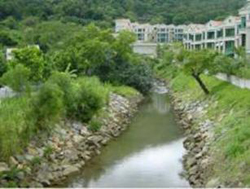 |
Tai Po Kau Stream has benefited from the water quality improvement, which was upgraded from ‘Very Bad’ to ‘Excellent’ in the last 20 years |
|
The general tenor of this report has been one
of optimism: in almost all cases, after a raft of remedial measures
introduced in the late 1980s and 1990s, river water quality across
Hong Kong has improved substantially. In terms of compliance with
the statutory WQOs, this has shown itself in a steady rise in
compliance rates, as illustrated by the accompanying graph. From
just a 49% overall compliance rate in 1986—falling further to 47% in
1987—the rate moved steadily upwards through the 1990s to finally
break the 80% level in 2000. Since then it has remained more or less
steady, but the 85% compliance recorded for 2005 represented the
highest ever since monitoring began.
 |
|
 |
|
| WQO compliance in the inland waters of Hong Kong, 1986 - 2005 |
|
|
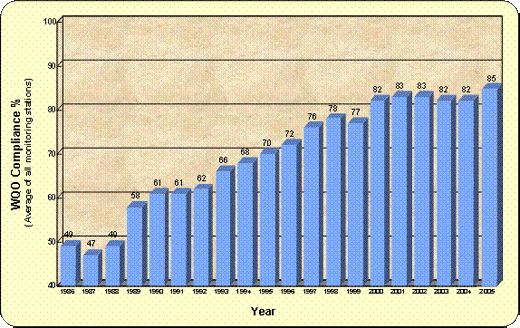 |
 |
|
 |
A similar but perhaps more striking trend has
shown itself in terms of Water Quality Index grades, which reflect
the general health of rivers. The chart below shows a dramatic move
from a situation in 1986 where the majority of stations recorded
‘Bad’ or ‘Very Bad’ grades, to the situation in 2005 when 81% of
stations were graded either ‘Excellent’ or ‘Good’.
 |
|
 |
|
| Water Quality Index gradings for the inland waters of Hong Kong, 1986 - 2005 |
|
|
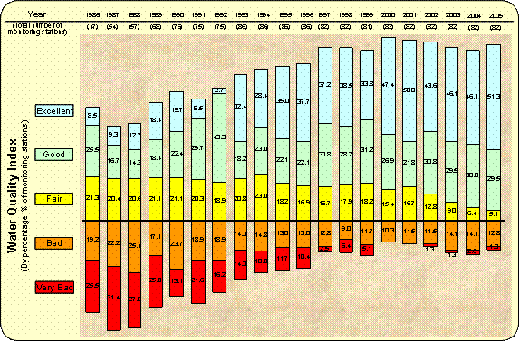 |
 |
|
 |
Improvements arising from enforcing the Water Pollution Control Ordinance
One recurring theme of this report has been
the improvements made possible once the EPD was able to enforce the
Water Pollution Control Ordinance (WPCO), which happened
progressively across Hong Kong as individual Water Control Zones
were established between 1987 and 1996. Regular inspections of
dischargers have been and continue to be conducted, and many
expedient connections and polluting discharges have been rectified.
One way of measuring the impact of the various initiatives is by
calculating the ‘pollution load’ being carried by rivers and
comparing these pollution loads across time. It is estimated that
WPCO enforcement has resulted in an over 80% reduction in the
domestic, industrial, commercial and institutional pollution load of
the rivers monitored over the past twenty years.
 |
|
 |
|
| The impact of the Water Pollution Control Ordinance on river pollution loads |
|
|
Regions |
Before control
(kg BOD/day)
|
At end of 2005
(kg BOD/day)
|
Percentage reduction |
Eastern New Territories
(sum of 7 rivers)
|
13,365 |
2,566 |
81% |
Northwestern New Territories
(sum of 11 rivers)
|
20,095 |
3,990 |
80% |
Lantau Island
(Mui Wo River)
|
15 |
0 |
100% |
Southwestern New Territories and Kowloon
(sum of 4 rivers)
|
7,204 |
511 |
93% |
Total (23 rivers) |
40,679 |
7,067 |
83% |
|
 |
|
 |
Improvements arising from the Livestock Waste Control Scheme
As has been demonstrated continually
throughout this report, one of the most significant permanent
changes to have affected river water quality was the introduction of
the Livestock Waste Control Scheme under the Waste Disposal
Ordinance in 1988, which had the dual effect of encouraging many
farmers to close down their polluting livestock operations, and of
requiring those that remained in business to treat their livestock
waste to specified standards. It is estimated that 90% of the
pollution load from livestock farms has been removed since the
regulation took effect. Most of this reduction took place in the
rivers of the Northwestern New Territories, where the bulk of
livestock farming was concentrated.
 |
|
 |
|
| The impact of the Livestock Waste Control Scheme on river pollution loads |
|
|
Regions |
Before control
(kg BOD/day) |
At end of 2005
(kg BOD/day) |
Percentage reduction |
Eastern New Territories
(sum of 7 rivers) |
3.033 |
0 |
100% |
Northwestern New Territories
(sum of 11 rivers) |
67,187 |
1,620 |
98% |
Lantau Island
(Mui Wo River) |
178 |
0 |
100% |
Southwestern New Territories and Kowloon
(Tuen Mun River)
|
9,520 |
0 |
100% |
Total (20 rivers) |
79,918 |
1,620 |
98% |
|
 |
|
 |
Sewerage improvements
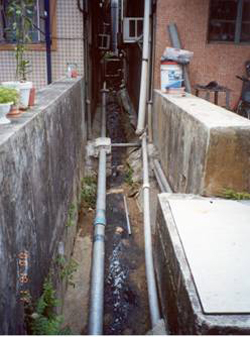 |
Village house waste water discharged
into open channel (before sewer connection) |
|
|
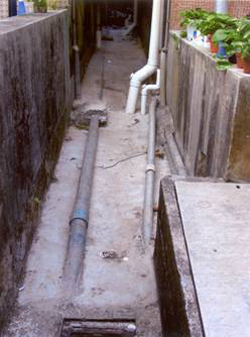 |
Village house waste water connected
to sewer |
|
Finally, the Government initiated
improvements to the sewerage infrastructure by preparing and
implementing the 16 Sewerage Master Plans since 1987 that provide
blueprints for a comprehensive sewerage network covering all of Hong
Kong. The improved sewerage infrastructure has helped minimise
sewage pollution in rivers in some areas, especially in the Eastern
New Territories. Reviews of the plans have been carried out in the
light of new population forecasts and changing patterns of urban
development. Further progressive extension of the sewerage system
and upgrading of the existing network has also taken place, with
clearly positive results for many areas of river water.
Specific initiatives for the future
Hong Kong’s problems with pollution of its
river waters are not completely solved yet, as this report has
pointed out in various places. Some 14% of monitoring stations still
received WQI grades of ‘Bad’ or ‘Very Bad’ in 2005, and the EPD’s
target is to have none obtaining such grades. It is clear that this
pollution is largely being caused by remaining livestock farms and
by the large areas of village housing that are still unsewered.
The Government has put aside more than $8
billion to fund new sewerage programmes in Hong Kong over the next
eight or nine years. As public sewers are extended throughout Hong
Kong under the various Sewerage Master Plans and their reviews, the
EPD will continue to require village house owners to connect to the
public sewer as soon as it becomes available, or maintain efficient
septic tanks so as to minimise pollution from village areas. The
ongoing enforcement of the Water Pollution Control Ordinance is
continuing to ensure that expedient connections are eliminated, and
other polluting discharges are dealt with quickly and effectively.
Livestock waste should be further reduced
under the Government’s Voluntary Surrender of Poultry and Pig Farm
Licence Schemes, initiated in 2005 and 2006 respectively. These
schemes invite pig and poultry farmers to turn in their Government
livestock licences, for which they will be compensated financially.
Poultry farmers opting for the scheme have to close down in 2007.
Further improvements in river water quality as a result of this
initiative are expected in the next few years.
River water quality monitoring
As further changes take place over the coming
years, the EPD will continue its comprehensive programme of
monitoring and reporting on river water quality so that detailed,
scientific information about Hong Kong’s rivers remains widely
available to everyone who requires it. Since 1986, the programme has
been reporting on the health of Hong Kong’s major rivers, and
providing evidence of the critical work necessary to save some of
them. Over the years, the programme has been important in helping
the Government assess compliance with its Water Quality Objectives,
and evaluate how effective its various water quality control
measures have been. It has also created a solid basis for the
planning of future pollution controls and initiatives. After twenty
years of providing this service, the EPD is proud of the programme’s
achievements, and is looking forward to many more years of its
successful operation.
 |
The EPD will continue to monitor river water quality and provide scientific data
for future planning and pollution control work (Photograph taken in the Shing Mun River) |
|
|